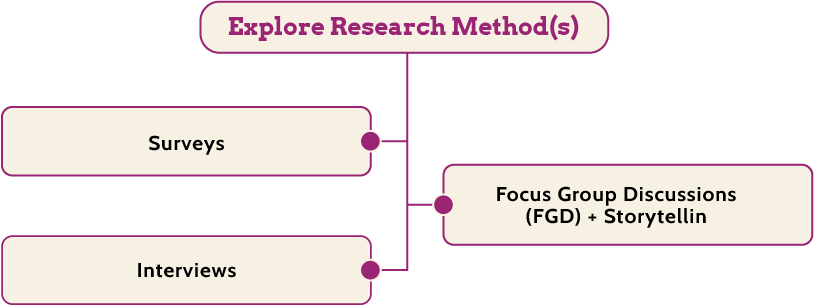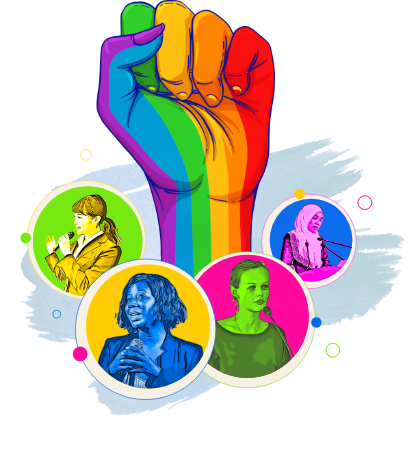We can strive to create meaningful change through our design choices. Or better yet, we can design by learning and creating alongside those closest to the issues. And by doing so, we can put the power of design rightfully back into their hands.


STEP 2: DESIGN
With care, a seed develops a healthy root system—building the foundation of your consultation.
Decide on research questions and select your research methods. Design is an exciting and dynamic step where creativity runs free!


research principles
Focus on Community Impact
Always be mindful of the impact your consultation may have on the community.
Foster a Collaborative Relationship between Researcher and Participant
Work together to adapt the Methodology by using their ideas to produce new insights. Consider training co-researchers and other women to help gather data and analyse results. Remember when working with co-researchers to uphold trust, respect, and transparency.


Ensure Gender Inclusivity
Being inclusive means eliminating the barriers in the way of people being who they are. Be intentional when designing research activities to ensure participants feel safe, valued, and respected.
Gather and Protect Data with Respect
Thoughtful use of data enables community empowerment.
Anchor Efforts on Research Objectives
Always ensure you are answering your research question(s).
Combine Research Methods (when applicable)
The three research methods outlined in this Methodology are not interdependent. Instead, they can be singular or combined with one another.


Double Down on Documentation
Save all notes. You never know when you (or another stakeholder) may need to reference it.
Create Field Guides
Develop field guides to support the implementation of your selected research method(s). Field guides promote consistency while offering flexibility to adapt in real time (see the Focus Group Discussion + Storytelling Field Guide and Interview Field Guide).
Foster Safe Spaces and Respect
Promote dignity by conducting your consultation using the World YWCA’s safe space23 framework.

Host Joint Work Sessions
Conduct joint work sessions with participants. Work together to interpret and reflect on the findings. This results in many perspectives helping to shape the findings.

Encourage Diversity of Thought
Involve voices from different groups to embrace diversity of thought. Doing so helps achieve a more complete vision of reality. (See Sampling for details on how to select different groups to be part of your consultation.)
Share Knowledge and Skill Development Opportunities
Build in opportunities to share Snowledge and train participants on how to use the Methodology. Doing so helps develop skills in young women. It also ensures the Methodology can be repeated with sustained impact.
Build and Tap into Support Networks
Creating networks between participants can contribute to trust building, collaboration, and knowledge sharing.

How you speak matters. Language choice and clarity can both impact the success of your consultation. What you say and how you say it can influence the overall experience for your consultation. This is especially true when engaging participants.
Acknowledge the power of language
It is important to acknowledge the power of language. There has been much work done to democratise language. In other words, ensuring language is accessible, inclusive, and representative of its audience.

Understand the context
Take the time to understand the context of the space in which you wish to do your consultation. Then use this understanding to guide your choice and use of words.
Adjust to fit the context
Adjust the Methodology’s language based on your context. Be sure to maintain the original spirit of the text. Do so while ensuring everyone feels comfortable and safe with the terminology.
Recognise intersectionality
Your language must reflect the intersectional identities and experiences of your participants. This is especially true if your consultation is global. Or if your consultation involves women from different walks of life.
Combine research methods (when applicable)
The three research methods outlined in this Methodology are not interdependent. Instead, they can be singular or combined with one another.
Leverage digital translation tools (with caution)
Digital translation tools can be helpful for working in different languages. That said, these tools have their limitations. If translating the Methodology using a digital tool, be sure to validate it.
Be mindful of similarities and differences of languages
If working across many languages using translated materials, keep in mind the similarities and differences of languages
Keep it simple
Use simple language to reach the greatest number of people. Maintain a neutral tone and avoid slang whenever possible. Use local dialects when working locally and consider more widely understood language when working across different contexts.

Use empowering definitions
Your goal is for all participants to understand and feel comfortable sharing. When deciding on definitions, be mindful of deeply rooted dynamics like power and gender inequality.
Separate the “I” from the “we”
Use words to make participants and co-researchers feel part of the process. Be mindful of power dynamics and focus on using “we” instead of “I” when talking about the consultation.
Refer to people the way in which they want to be referred
Show respect by using the language people ask you to use. Always bear in mind language is both a descriptor and a generator of reality.
Assess the language of your tools before using
After designing your data collection tools, spend some time validating them. Assess the language by reviewing key elements such as vocabulary, tone of voice, clarity, relevance to context, and connection to your research objectives.

Principles of Feminist Safe Spaces and Security
A core focus of this Methodology is ensuring safety and security. To be feminist means to nurture safe spaces and experiences. Security means promoting individual and collective care. Be sure to care for everyone involved in your consultation. This includes your participants, research team, partners, and other stakeholders.

key asks
Developing questions and key asks is a critical piece of the design step. This is where you look at your research objectives and determinethe best questions to ask.











how many to engage








(FGD) + Storytellin








